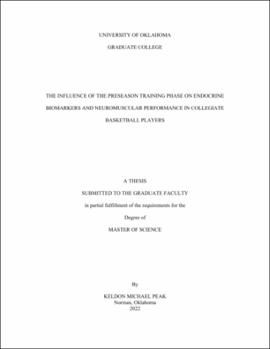| dc.description.abstract | Introduction: Elite athletes undergo vigorous training in the effort to initiate physiological responses that over time accumulate to cause positive adaptation, which result in improvements in physical performance. The training stimuli elicit responses from the endocrine and neuromuscular systems that play a part in adaptations and states of recovery. Approaches have been used to monitor the status of the athletes including observing changes in biochemical markers or neuromuscular performance. The preseason is thought to be very strenuous on the players in that they are in the midst of academic stressors as well as the physically taxing nature of the sport in parallel with energy system development and resistance training in preparation to build the resiliency for the duration of the season. Monitoring biochemical markers in conjunction with neuromuscular performance may provide useful information for the evaluation of recovery and strain of the athlete. Coupling the measurements of testosterone (T) and cortisol (C) for hormonal analyses and a sport specific performance test may enhance capacities as a performance practitioner to adjust training sessions in the attempt to enable optimal recovery and positive adaptations. Purpose: The primary purpose of this study was to evaluate changes in biochemical markers, specifically Testosterone and Cortisol, and the Testosterone:Cortisol (T:C) ratio, as well as neuromuscular performance over the course of the preseason. Methods: This retrospective study included 15 male NCAA Division I basketball players that participated in sport specific training sessions in the preseason training phase. Participants provided written informed consent for their data to be included in the analyses, de-identified data was given to the research team by the athlete performance staff for analysis. Participants provided a salivary sample on a day of no activity that served as the baseline assessment sample. Prior to practice, participants provided a salivary sample used to assess T, C, and T:C ratio as well as performed 3 CMJs on a dual cell force platform to evaluate neuromuscular performance. Following practice, participants provided another salivary sample and performed 3 more CMJs. Participants returned at the end of the preseason training phase four weeks later where they repeated the activities prior to practice and at the conclusion of practice. The eTL of each practice was captured through IMU devices and iTL was assessed through HR monitors and RPE scales. Statistical Analyses: Data normality was confirmed through the Shapiro-Wilk test statistic. The data was also tested for sphericity through Mauchly’s test to confirm variance in differences were similar between groups. If the data indicated the assumption of sphericity is violated through Mauchly’s Test of Sphericity, then the Greenhouse-Geisser correction was used to combat the violation. A paired t-test was used to evaluate the within subject differences in eTL parameters as well as iTL parameters across time. A two-way (Week [Week 1, Week 4] × Time [Pre-Practice, Post-Practice]) repeated measures (RM) analysis of variance (ANOVA) was used to examine Week and Time main effects and the interaction between week and time in CMJ variables. Additionally, the two-way RM ANOVA was used the evaluate the salivary endocrine measures. Statistical significance was set at p ≤ 0.05. If a significant interaction was determined, a Bonferroni post hoc analysis was performed to isolate simple main effects. When comparing two groups, Cohen’s d (d) effect sizes were utilized and interpreted as trivial (0 – 0.19), small (0.20 – 0.49), medium (0.50 – 0.79), and large (≥ 0.80). The intra- and inter-assay reliability of the hormone assay duplicates were evaluated using the coefficient of variation (CV%). Results: While not practically significant, the only significant difference seen in eTL was Duration, otherwise there were no significant differences observed in eTL or iTL between weeks. There were significant differences in CMJ variables, including EccMF, ConcPF, and Body Mass. For EccMF and Body Mass, the average of the Pre values from Week 1 and Week 4 were significantly lower than the average of the Post values from Week 1 and Week 4. In addition, ConcPF displayed a significant increase from Pre to Post in Week 1 but not in Week 4. However, when the CMJ performances were made relative to Body Mass, no significant differences were exhibited. No significant differences emerged in comparison across the Baseline Assessment and Pre values to examine the influence of an anticipatory effect. Although, T and C both displayed an increase in concentration of the average of the Pre values from Week 1 and Week 4 to the Post values from Week 1 and Week 4. Furthermore, C presented a significant increase from Pre to Post in Week 1, however, this was not apparent in Week 4. Moreover, the absolute change in C levels from Pre to Post in Week 1 was significantly higher than the absolute change produced in Week 4. The T:C ratio showed a significant increase from Week 1 Post to Week 4 Post. Also, the T:C ratio absolute and relative change experienced from Pre to Post in Week 1 was significantly lower than the absolute and relative change from Pre to Post in Week 4. Conclusion: These findings suggest neuromuscular performance remains unaltered over a single training exposure as well as throughout the preseason training phase in relation to body mass. Additionally, the cortisol response following four weeks of the preseason training phase showed to be blunted with the testosterone response unchanged resulting in a more anabolic state while examining the T:C ratio. Therefore, monitoring of physiological status may be of interest to gain insight of whether or not an individual is approaching concerning levels. | en_US |
